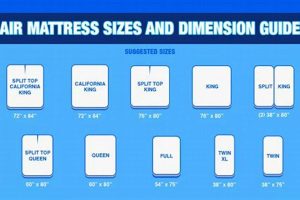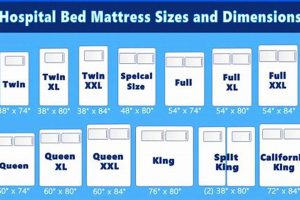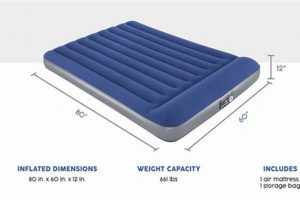The measurements of a mattress designed for smaller cribs, often employed in urban dwellings or as a secondary sleep space, are a crucial factor in ensuring infant safety and comfort. These mattresses are significantly smaller than those used in standard cribs, typically conforming to a length around 38 inches and a width around 24 inches. Understanding these specific measurements is essential for selecting the appropriate bedding and ensuring a secure fit within the crib frame.
The adoption of appropriately sized mattresses within compact cribs offers numerous advantages. These include efficient utilization of limited space, portability, and often, a more economical price point compared to standard-sized alternatives. Historically, such compact sleeping arrangements have been favored in settings where space constraints are a primary consideration, allowing parents to maintain proximity to their child without sacrificing valuable room.
The subsequent sections will delve into considerations for choosing the right mattress, including safety standards, material options, and the implications of these factors for infant well-being. The focus will be on providing a comprehensive guide to selecting the ideal sleep surface for compact cribs, promoting both infant safety and parental peace of mind.
Guidance on Compact Crib Mattress Specifications
The following recommendations address key considerations when assessing mattress measurements for smaller cribs, prioritizing infant safety and optimal sleep environment.
Tip 1: Verify Mattress Fit: Precise measurements are critical. Ensure the mattress fits snugly within the crib frame, with no gaps exceeding two finger widths along any side. This minimizes the risk of entrapment.
Tip 2: Adhere to Safety Standards: Confirm the mattress meets current safety regulations, such as those established by the Consumer Product Safety Commission (CPSC). This ensures the product has undergone rigorous testing for harmful substances and construction integrity.
Tip 3: Consider Mattress Thickness: Mattress thickness should be appropriate for the crib’s design. Consult the crib manufacturer’s specifications for recommended mattress thickness to avoid compromising the safety rails.
Tip 4: Assess Mattress Firmness: A firm mattress surface is essential for infant safety. Softer surfaces can pose a suffocation hazard. Verify the mattress provides adequate support for the infant’s weight.
Tip 5: Evaluate Material Composition: Opt for materials that are non-toxic, hypoallergenic, and breathable. Consider organic cotton or other natural fibers to minimize exposure to potentially harmful chemicals.
Tip 6: Examine Seam Integrity: Inspect the mattress seams for durability and secure stitching. Weak or poorly constructed seams can lead to premature wear and potential hazards.
Tip 7: Review Warranty Information: A comprehensive warranty indicates the manufacturer’s confidence in the product’s quality and longevity. Review the warranty terms and conditions before making a purchase.
Selecting a mattress that conforms to appropriate spatial parameters and safety guidelines ensures a secure and comfortable sleep environment for the infant. Diligence in these considerations contributes directly to infant well-being.
The concluding section will synthesize the information presented, highlighting key recommendations and providing guidance on long-term mattress maintenance and replacement.
1. Width specification
Width specification is a critical component of the overall spatial definition for compact crib mattresses. It directly influences the mattress’s ability to fit securely within the crib frame, thereby preventing hazardous gaps. Deviations from the intended width, even by small margins, can create spaces where an infant could become entrapped. For example, a mattress with a width of 23 inches in a crib designed for a 24-inch width can leave a gap large enough to pose a safety risk. Understanding width specification is, therefore, essential for ensuring regulatory compliance and promoting infant safety.
The practical implications of adhering to precise width specifications extend to manufacturing and quality control. Manufacturers must maintain stringent standards to ensure consistency in product dimensions. Retailers and consumers must also verify the accuracy of width measurements prior to purchase and use. Failure to do so can negate the intended safety features of the crib and mattress combination. The width parameter is therefore not simply a measurement, but a critical safety feature.
In summary, the width specification is inextricably linked to the safety and functionality of compact crib mattresses. Its adherence directly affects the risk of infant entrapment and underscores the importance of rigorous manufacturing standards. Continued emphasis on precise width measurements is paramount for safeguarding the well-being of infants using compact cribs.
2. Length requirements
The length requirements of a mattress designed for compact cribs constitute a critical dimensional parameter directly influencing infant safety and comfort. As a core component of compact crib mattress specifications, the length dictates how securely the mattress fits within the crib frame. Discrepancies between the stated length and the actual measurement can create gaps, posing a risk of infant entrapment. For example, a mattress labeled as 38 inches in length that measures slightly shorter may leave a hazardous space along the crib’s edge. Precise adherence to specified length requirements is therefore not merely a matter of convenience, but of safety imperative. The specified length must align with the internal dimensions of the compact crib for which it is intended, ensuring a snug fit that eliminates potential hazards.
Consider the practical application of these requirements: manufacturers of cribs and mattresses must collaborate to ensure dimensional compatibility. Retailers must accurately represent the product dimensions, and consumers must verify these dimensions upon purchase. Consistent enforcement of length standards contributes directly to minimizing the risk of accidents within the crib environment. The effects of non-compliance can be severe, leading to potential injury or even fatality. Therefore, adherence to length regulations is paramount throughout the entire supply chain, from manufacturing to consumer use. A regulatory framework reinforces the importance of these dimensional mandates to prevent adverse incidents.
In summary, length requirements are a fundamental aspect of compact crib mattress design, directly impacting infant safety. Strict adherence to specified lengths minimizes the risk of entrapment and ensures optimal functionality of the sleep environment. Understanding the practical significance of these dimensional parameters, along with consistent adherence to industry standards, is crucial for both manufacturers and consumers. The well-being of infants depends on meticulous attention to these details, reinforcing the critical role of length requirements in compact crib design.
3. Thickness tolerances
Thickness tolerances, in the context of compact crib mattresses, represent the permissible variance in the vertical dimension of the mattress. This dimension, inextricably linked to overall measurements, directly influences the fit and safety profile within the confines of a compact crib frame. Exceeding the upper tolerance can compromise the height of the crib’s safety rails, potentially allowing a child to climb out. Conversely, falling below the lower tolerance may create hazardous gaps between the mattress and the crib sides, presenting an entrapment risk. Therefore, strict adherence to established thickness tolerances is not merely a manufacturing detail, but a critical safety consideration.
The implications of non-compliance with thickness tolerances extend beyond immediate safety concerns. For instance, a mattress that consistently exceeds the upper thickness tolerance could exert undue stress on the crib’s structural components, potentially leading to premature wear or even failure. Similarly, a mattress consistently thinner than specified may not provide adequate support for the infant, compromising sleep quality and potentially affecting physical development. In a real-world scenario, a batch of mattresses with a thickness variance of +/- 0.5 inches from the specified dimension of 4 inches could either render the crib unsafe or provide inadequate support, impacting a significant number of users. The practical significance of understanding and enforcing thickness tolerances is therefore undeniable, affecting both immediate safety and long-term product performance.
In conclusion, thickness tolerances are a crucial element within the framework of compact crib mattress specifications, directly impacting safety, structural integrity, and infant comfort. Challenges in maintaining strict adherence to these tolerances underscore the need for rigorous quality control measures throughout the manufacturing process. By recognizing the critical role of this dimension, manufacturers, retailers, and consumers can collectively contribute to ensuring the safety and well-being of infants within the confines of compact crib environments.
4. Corner radius
Corner radius, as a specific attribute within mini crib mattress spatial specifications, directly influences the fit and safety characteristics of the sleep environment. This parameter refers to the curvature of the mattress’s corners, which must correspond precisely to the internal corner geometry of the mini crib frame. A mismatch between the corner radius of the mattress and the crib can result in gaps along the crib’s perimeter, creating potential entrapment hazards for an infant. For instance, a mattress with excessively sharp corners placed in a crib with rounded corners will invariably leave spaces where a child’s limbs could become lodged. Consequently, the corner radius must be carefully considered as an integral component of overall mattress measurements.
The practical significance of the corner radius becomes evident during manufacturing and quality control processes. Mattress manufacturers must employ precise cutting and shaping techniques to ensure consistent corner curvature across their product lines. Crib manufacturers, likewise, must adhere to defined corner specifications in the crib design. Any deviation in either product’s corner radius can compromise the intended safety and functionality of the crib-mattress system. Retailers and consumers share the responsibility of verifying dimensional compatibility, paying particular attention to corner fit, to prevent potential hazards. Consistent enforcement of these corner radius standards throughout the product lifecycle minimizes the risk of adverse events.
In summary, the corner radius represents a critical, yet often overlooked, aspect of mini crib mattress dimensions. Its adherence to specified parameters directly affects infant safety by preventing hazardous gaps within the crib environment. By understanding the importance of this seemingly minor detail, and by implementing rigorous quality control measures, manufacturers, retailers, and consumers can collectively contribute to creating a safer sleep space for infants. Attention to corner radius promotes a more secure and comfortable sleep environment.
5. Weight considerations
Weight considerations, in the context of mini crib mattress dimensions, represent a crucial factor affecting both the structural integrity of the crib and the ease of mattress handling. The mass of the mattress, inextricably linked to its size and material composition, must fall within a range compatible with the crib’s design specifications.
- Crib Structure Compatibility
Excessive mattress weight can place undue stress on the crib frame, potentially leading to structural failure over time. Conversely, an underweight mattress may indicate insufficient density or compromised materials, affecting infant support and safety. For example, a mini crib designed to support a mattress weighing between 5 and 7 pounds could be compromised by a mattress exceeding 8 pounds, potentially weakening joints or causing warping.
- Portability and Handling
Mini cribs are often selected for their portability, and the mattress weight directly impacts this attribute. A lighter mattress facilitates easier lifting and repositioning, particularly when changing linens or moving the crib. A heavier mattress, while potentially indicating denser materials, can make these tasks more cumbersome. A mattress weighing less than 5 pounds may be easily transported but might lack the necessary support for extended use, while a mattress exceeding 7 pounds could present handling challenges.
- Material Density and Composition
The weight of a mini crib mattress is intrinsically linked to its material density and composition. Mattresses constructed from high-density foam or incorporating heavier materials will naturally weigh more. These materials may offer enhanced support and durability but can also increase the overall weight of the mattress. A mattress filled with organic cotton might weigh less than one filled with synthetic foam, but the latter might provide firmer support.
- Safety Standard Compliance
Weight considerations are indirectly linked to safety standards. Regulations often specify minimum density or material requirements, which in turn influence the mattress weight. Compliance with these standards necessitates careful material selection to ensure both adequate support and acceptable weight limits. A mattress that uses lighter, less dense materials to reduce weight might fail to meet minimum safety requirements for firmness and support.
These facets demonstrate that weight considerations are not isolated measurements but are intricately connected to crib structure compatibility, portability, material density, and safety standards. Understanding the interplay between these factors is crucial for selecting a mini crib mattress that provides optimal safety, support, and convenience.
6. Density characteristics
Density characteristics, a critical component of mini crib mattress dimensions, refer to the mass per unit volume of the mattress material. This parameter directly influences the firmness, support, and durability of the mattress, impacting infant safety and comfort. A mattress with inadequate density may lack sufficient support, potentially leading to postural issues or increasing the risk of suffocation. Conversely, excessive density can result in a rigid surface, causing discomfort and hindering restful sleep. The relationship between density characteristics and mini crib mattress dimensions is, therefore, a cause-and-effect dynamic where material composition dictates supportiveness within a defined spatial parameter. For example, a low-density foam mattress, despite conforming to correct length and width measurements, may not provide adequate spinal support for a growing infant.
The practical significance of understanding density characteristics extends to material selection and manufacturing processes. Manufacturers must carefully choose materials and control their density to meet safety regulations and performance expectations. Density is often measured in pounds per cubic foot (lbs/ft) and is a key specification in product descriptions. For example, a mini crib mattress with a density of 1.5 lbs/ft might be considered suitable for infants, while a density below 1.0 lbs/ft could be deemed insufficient. In the real world, discrepancies in density can lead to consumer dissatisfaction, safety recalls, and potential harm to infants. Therefore, understanding and controlling density characteristics is essential for producing safe and effective mini crib mattresses.
In summary, density characteristics are an indispensable element of mini crib mattress dimensions, directly affecting mattress performance and infant well-being. Strict adherence to specified density ranges is crucial for ensuring adequate support, safety, and durability. The challenges associated with maintaining consistent density levels underscore the need for rigorous quality control measures throughout the manufacturing process, linking directly to the overarching goal of providing a safe and comfortable sleep environment for infants. The selection of materials, manufacturing processes, and quality control measures are all impacted by the density demands for a mini crib mattress to work effectively.
Frequently Asked Questions
The following questions address common inquiries regarding the spatial specifications for mattresses designed for compact cribs.
Question 1: What are the typical length and width parameters?
Standard length and width measurements are approximately 38 inches and 24 inches, respectively. Deviations from these dimensions can compromise safety.
Question 2: Why is precise measurement adherence crucial?
Precise adherence to specified spatial parameters minimizes the risk of infant entrapment within the crib frame.
Question 3: What thickness range is generally recommended?
The recommended thickness typically falls between 3 and 6 inches. Consult the crib manufacturer’s guidelines for specific recommendations.
Question 4: How does mattress weight impact safety?
Excessive weight can compromise the structural integrity of the crib. Underweight options may lack adequate support.
Question 5: What is the significance of corner radius?
A proper corner radius ensures a snug fit within the crib corners, preventing potential gaps and entrapment hazards.
Question 6: How do density characteristics influence mattress performance?
Appropriate density ensures adequate support and prevents suffocation risks. Insufficient density can compromise infant safety.
Consistent adherence to these spatial and material specifications ensures a secure and comfortable sleep environment for infants.
The subsequent section will provide detailed guidance on selecting materials and assessing safety certifications.
Mini Crib Mattress Dimensions
This article has presented a detailed exploration of mini crib mattress dimensions, emphasizing the critical role of precise measurements in ensuring infant safety. Adherence to specified length, width, thickness, corner radius, weight, and density parameters is not merely a matter of convenience but a fundamental prerequisite for creating a secure sleep environment. The consequences of dimensional discrepancies can range from structural compromise of the crib to increased risks of infant entrapment and suffocation. Diligence in selecting a mattress that conforms to established spatial specifications is paramount.
The information provided underscores the responsibility of manufacturers, retailers, and consumers in upholding safety standards. Continued vigilance in maintaining quality control, accurate product representation, and informed purchasing decisions is essential. The well-being of infants depends on the collective commitment to prioritizing safety considerations in the design, production, and selection of mini crib mattresses. Therefore, strict attention to dimensional requirements must remain a cornerstone of infant care practices.







